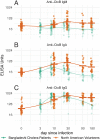Immune responses to O-specific polysaccharide (OSP) in North American adults infected with Vibrio cholerae O1 Inaba
- PMID: 31743334
- PMCID: PMC6863522
- DOI: 10.1371/journal.pntd.0007874
Immune responses to O-specific polysaccharide (OSP) in North American adults infected with Vibrio cholerae O1 Inaba
Abstract
Background: Antibodies targeting O-specific polysaccharide (OSP) of Vibrio cholerae may protect against cholera; however, little is known about this immune response in infected immunologically naïve humans.
Methodology: We measured serum anti-OSP antibodies in adult North American volunteers experimentally infected with V. cholerae O1 Inaba El Tor N16961. We also measured vibriocidal and anti-cholera toxin B subunit (CtxB) antibodies and compared responses to those in matched cholera patients in Dhaka, Bangladesh, an area endemic for cholera.
Principal findings: We found prominent anti-OSP antibody responses following initial cholera infection: these responses were largely IgM and IgA, and highest to infecting serotype with significant cross-serotype reactivity. The anti-OSP responses peaked 10 days after infection and remained elevated over baseline for ≥ 6 months, correlated with vibriocidal responses, and may have been blunted in blood group O individuals (IgA anti-OSP). We found significant differences in immune responses between naïve and endemic zone cohorts, presumably reflecting previous exposure in the latter.
Conclusions: Our results define immune responses to O-specific polysaccharide in immunologically naive humans with cholera, find that they are largely IgM and IgA, may be blunted in blood group O individuals, and differ in a number of significant ways from responses in previously humans. These differences may explain in part varying degrees of protective efficacy afforded by cholera vaccination between these two populations.
Trial registration number: ClinicalTrials.gov NCT01895855.
Conflict of interest statement
I have read the journal’s policy and the authors of this manuscript have the following competing interests: Jakub K. Simon, Michael Lock, and Marc Gurwith were employed by PaxVax, Inc. Wilbur H. Chen, Caroline E. Lyon, Beth D. Kirkpatrick, Mitchell Cohen, and Myron M. Levine received research funding from PaxVax, Inc. Jakub K. Simon is currently employed by Merck & Co. All other authors report no potential conflicts.
Figures




Similar articles
-
Anti-O-specific polysaccharide (OSP) immune responses following vaccination with oral cholera vaccine CVD 103-HgR correlate with protection against cholera after infection with wild-type Vibrio cholerae O1 El Tor Inaba in North American volunteers.PLoS Negl Trop Dis. 2018 Apr 6;12(4):e0006376. doi: 10.1371/journal.pntd.0006376. eCollection 2018 Apr. PLoS Negl Trop Dis. 2018. PMID: 29624592 Free PMC article. Clinical Trial.
-
Comparison of immune responses to the O-specific polysaccharide and lipopolysaccharide of Vibrio cholerae O1 in Bangladeshi adult patients with cholera.Clin Vaccine Immunol. 2012 Nov;19(11):1712-21. doi: 10.1128/CVI.00321-12. Epub 2012 Sep 19. Clin Vaccine Immunol. 2012. PMID: 22993410 Free PMC article.
-
Induction of systemic, mucosal and memory antibody responses targeting Vibrio cholerae O1 O-specific polysaccharide (OSP) in adults following oral vaccination with an oral killed whole cell cholera vaccine in Bangladesh.PLoS Negl Trop Dis. 2019 Aug 1;13(8):e0007634. doi: 10.1371/journal.pntd.0007634. eCollection 2019 Aug. PLoS Negl Trop Dis. 2019. PMID: 31369553 Free PMC article.
-
Protection afforded by previous Vibrio cholerae infection against subsequent disease and infection: A review.PLoS Negl Trop Dis. 2021 May 20;15(5):e0009383. doi: 10.1371/journal.pntd.0009383. eCollection 2021 May. PLoS Negl Trop Dis. 2021. PMID: 34014927 Free PMC article. Review.
-
[Cholera vaccine].Nihon Rinsho. 2005 May;63 Suppl 5:625-30. Nihon Rinsho. 2005. PMID: 15954420 Review. Japanese. No abstract available.
Cited by
-
Sero-evaluation of Immune Responses to Vibrio cholerae in a Postelimination Setting.Open Forum Infect Dis. 2020 Apr 21;7(5):ofaa136. doi: 10.1093/ofid/ofaa136. eCollection 2020 May. Open Forum Infect Dis. 2020. PMID: 32462045 Free PMC article.
-
A dysbiotic gut microbiome suppresses antibody mediated-protection against Vibrio cholerae.iScience. 2021 Nov 14;24(12):103443. doi: 10.1016/j.isci.2021.103443. eCollection 2021 Dec 17. iScience. 2021. PMID: 34877500 Free PMC article.
-
Long-Term Kinetics of Serological Antibodies against Vibrio cholerae Following a Clinical Cholera Case: A Systematic Review and Meta-Analysis.Int J Environ Res Public Health. 2022 Jun 10;19(12):7141. doi: 10.3390/ijerph19127141. Int J Environ Res Public Health. 2022. PMID: 35742404 Free PMC article.
-
Identification and genomic analysis of a Vibrio cholerae strain isolated from a patient with bloodstream infection.Heliyon. 2022 Nov 17;8(11):e11572. doi: 10.1016/j.heliyon.2022.e11572. eCollection 2022 Nov. Heliyon. 2022. PMID: 36439761 Free PMC article.
-
Systemic, Mucosal, and Memory Immune Responses following Cholera.Trop Med Infect Dis. 2021 Oct 27;6(4):192. doi: 10.3390/tropicalmed6040192. Trop Med Infect Dis. 2021. PMID: 34842841 Free PMC article. Review.
References
-
- Hisatsune K, Kondo S, Isshiki Y, Iguchi T, Haishima Y. Occurrence of 2-O-methyl-N-(3-deoxy-L-glycero-tetronyl)-D-perosamine (4-amino-4,6-dideoxy-D-manno-pyranose) in lipopolysaccharide from Ogawa but not from Inaba O forms of O1 Vibrio cholerae. Biochem Biophys Res Commun. 1993;190(1):302–7. Epub 1993/01/15. 10.1006/bbrc.1993.1046 . - DOI - PubMed
Publication types
MeSH terms
Substances
Associated data
Grants and funding
LinkOut - more resources
Full Text Sources
Medical
Miscellaneous

